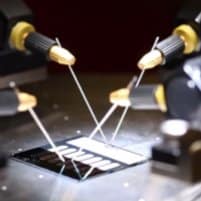An optical rectenna is like a radio antenna, except it works with the sun and can generate electricity.
Developed by engineers at the Georgia Institute of Technology who have solved a 40 year-old challenge, the optical rectenna works on the same sorts of principles as a radio antenna.
Tiny antennae match the size of the energy coming from the sun or visible light. When that energy is coupled into the antenna, then another device is used to extract it and convert it to electricity.
The antennae are metallic multiwall carbon nanotubes, which when exposed to light generate an oscillating charge that moves through rectifier devices attached to them, converting the alternating current (AC) into a direct current (DC).
The rectifier diodes switch on and off at a very rapid speed – in the petahertz range (a quadrillion hertz). The rectifier diode used is the fastest in the world – and the only one fast enough to open and close its ‘gate’ at the speed of solar energy oscillating in the antenna.
While the amount of current produced by a single rectenna is incredibly small, a forest of billions of tiny rectennas in an array can produce significant current.
The researchers still have a way to go as the efficiency of devices demonstrated to date remains below one percent. Still, they are very optimistic a commercially viable optical rectenna could be available within a year.
Should the technology evolve, it could prove very interesting in terms of solar applications.
“We could ultimately make solar cells that are twice as efficient at a cost that is ten times lower, and that is to me an opportunity to change the world in a very big way,” said Baratunde Cola, an associate professor in the George W. Woodruff School of Mechanical Engineering at Georgia Tech.
The researchers believe devices based on optical rectennas could achieve greater than 40 percent efficiency
Professor Cola and his team have set a goal of growing the optical rectennas on foil or other bendable material to create flexible solar cells.
Other applications for the optical rectenna include photodetectors able to operate without cooling systems and devices that could convert waste heat to electricity.
The team’s work has been published in in the journal Nature Nanotechnology.












































